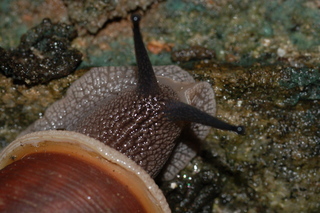Nutrition
How do snails obtain food?
Since snails are a slow moving organism, they must compensate by using their unique physical and internal structures in order to get food and nutrients. One adaption that snails like Inflectarius inflectus have made is a radula or food scraping structure. Made out of chitin, the radula can be used to scrape food off of the ground floor and carry it into the snail's mouth (Margulis and Schwartz 1998). Land snails have also developed a complex digestive system in order to break down food and absorb nutrients (Hickman et al. 2009).
How does oxygen and nutrients travel to tissues?
The Class Gastropoda, including Inflectarius inflectus, has an open circulatory system (Hickman et al. 2009). Included in the circulatory system are the heart enclosed in a chamber called the pericardium, blood vessels, and blood sinuses. Snails have hemolymph running through their bodies which can be analogous to a human's blood supply. Unlike humans, in a snail's open circulatory system, the hemolymph does not travel by blood vessels, but rather, travels freely through sinuses or channels over the tissues (Hickman et al. 2009). By having an open circulatory system, oxygen cannot be supplied to all tissues effectively which can be attributed to the slow pace of our snail and all terrestrial snails as well (Hickman et al. 2009).
What do snails eat?
While the study of the diet of Inflectarius inflectus is not thoroughly completed, we can attribute many of the same characteristics of common terrestrial snails to Inflectarius inflectus. For terrestrial snails algae, fungi, and seaweed are the main diet (Hickman et al. 2009). Along with herbivorous terrestrial snails, carnivorous and scavenger snails can be found eating flesh form other molluscs or finding nutrients from dead or decaying flesh respectively (Hickman et al. 2009).
